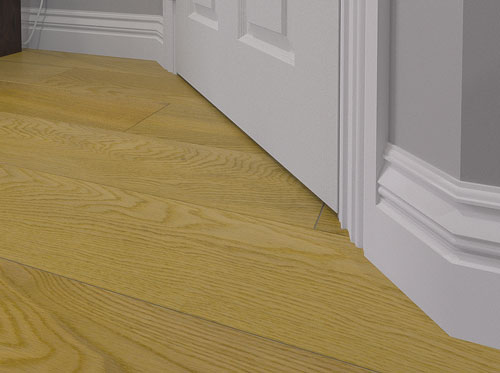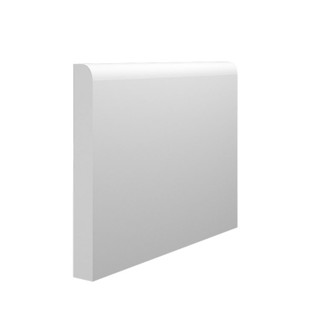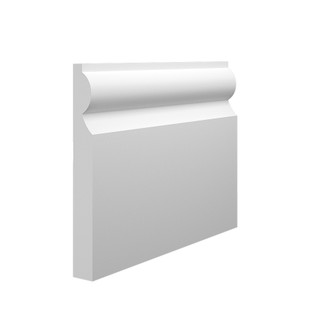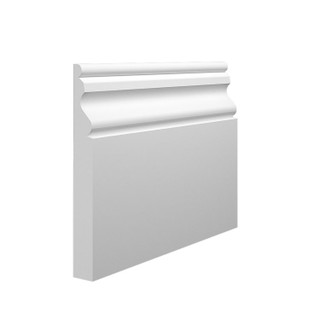
What Is Skirting? | Skirting Definition | Types Of Skirting Board
Posted by Lee Watkinson on 24th Nov 2023
Skirting is everywhere! You can find it in almost every residential and commercial British property and in properties around the world.
But how did skirting originate and why does everyone use it?
Read on to learn why skirting boards are used in homes, why and when they originated and the different types of skirting!
What Is Skirting?
Skirting (also known as baseboard) can be found in almost every home, you can find it framing the lowest part of the walls where the wall meets the floor, in every room. Often with ornate designs and painted white. Like the British favourite "330" Skirting Board profile seen below.
Skirting boards have been used for centuries to serve both functional and decorative purposes in buildings.
- Skirting originated in medieval times in Europe to cover the gaps between the walls and floor, gaps which were necessary in buildings made of stone or primitive mud walls that were not perfectly straight or level.
- Skirting boards helped to cover the uneven and unsightly gaps, prevent drafts and improve interior aesthetics by offering a more polished look to a rooms walls.
- In the 17th and 18th centuries, skirting evolved into a wider, more decorative element in wealthy European homes. Intricately carved wooden skirting boards demonstrated high status and style.
- Colonial American homes adapted simpler versions of ornamental skirtings from Europe (which they called "Baseboards") to finish interior spaces. Their functional was still partly practical - covering construction gaps - but also decorative.
- Today modern construction allows for more precision and ability to avoid gaps left at the bottom of walls, however skirting boards prevail as a design feature and have adapted to to conceal electrical wiring and central heating pipes inside skirting board rebates.
So in summary, skirting boards originated in medieval Europe to cover structural construction gaps but evolved to have decorative stylistic purposes over time while retaining some practical functions such as protecting interior walls in high foot traffic areas. They've been a key interior design element for hundreds of years all over the world.
Why Do We Need Skirting Boards?
Skirting boards serve several crucial functional and aesthetic purposes in homes and buildings. Here are the key reasons why quality skirting boards are still an essential architectural element:
Functional Purposes of Skirting
- Conceal Gaps & Wires: Skirting boards neatly conceal any small gaps or untidy spaces between the lower walls and floor. They provide a smooth finished edge. The rebate behind them can also hide electrical wires and cables around the room periphery.
- Insulation: Although small, the gap covered by skirtings provides thermal insulation and draft proofing, keeping interiors warmer. Useful in older buildings.
- Protection: Skirting boards protect the lower wall area from scuffs and marks made by furniture, feet or vacuum cleaners.
- Moisture Barrier: With a wood or water-resistant material like MDF, they form a barrier to moisture at floor level. This prevents decay or mould on vulnerable walls.
Aesthetic Purposes of Skirting
- Finishing Touch: Skirting boards give rooms a polished, complete look. The transition from wall to floor looks integrated and intentional rather than abrupt.
- Decorative Styling: Intricate skirting profiles bring architectural interest. Decorative tops enhance traditional or contemporary decors. Paint or wood stain colours integrate their look.
- Perception of Space: A contrasting colour to the walls gives the illusion of additional space and height in rooms. Dark skirtings also anchor light rooms.

Different Materials Used For Skirting
There are a few main types of skirting boards used in modern construction and home décor:
Wood Skirting
Pine, oak or maple wood boards offer a classic decorative look. Pine with moulded profiles are often used to add traditional elegance in living rooms or bedrooms. Stained oak or maple provide natural grain warmth. MDF boards with quality wood veneers combine stability and eco-friendly construction with the aesthetic appeal of real wood.
- Pine wood boards - Classic painted profile in various designs
- Oak, ash or maple - Stained real wood for decorative appeal
- MDF with wood veneer - Combines stability with natural wood finish
MDF Skirtings
Medium-Density Fibreboard (MDF) skirtings provide an affordable smooth surface ready for painting in your choice of colours. They work well in most rooms. MDF is stable and consistent. Decorative moulded MDF profiles emulate the ornate designs of plaster or wood at lower cost. Popular for front rooms.
- Plain MDF boards - Smooth primed surface ready for painting
- MDF with moulded profiles - Intricate decorative designs and shapes
Laminate Skirtings
MDF boards with hardwearing laminate surfaces have realistic wood grain textures. This resistant finish is useful for kitchens, bathrooms or high traffic areas prone to moisture and scuffs. They also match well with laminated flooring.
- Laminate on MDF core – Realistic wood grain patterns & textures
- Durable resistant laminate surface for bathrooms etc
Vinyl Skirtings
Durable, waterproof UPVC vinyl skirting boards suit bathrooms, basements and laundry rooms. Easy to wipe clean. The plastic construction resists moisture, warping and decay. Cost-effective choice.
- uPVC vinyl boards – Waterproof, hardwearing, moisture resistant
- Easy maintenance, wipe clean production
- Affordable pricing
Metal Skirtings
Sleek aluminium or stainless steel profiles provide a modern minimalist look in contemporary and commercial spaces. Work well with ceramic tiles or stone floors. High-end architectural aesthetic.
- Aluminium or stainless steel – Ultra modern, contemporary finish
- For commercial buildings or minimalist interiors
The variety of materials and designs provide decorative and functional options for different rooms, budgets and styles – from traditional ornate wood to sleek watertight bathroom vinyl. Skilled installers can advise the best type for each home.
Types of Skirting Boards and Their Uses
Wood Skirtings
Pine, oak or maple wood boards offer a classic decorative look. Pine with moulded profiles are often used to add traditional elegance in living rooms or bedrooms. Stained oak or maple provide natural grain warmth. MDF boards with quality wood veneers combine stability and eco-friendly construction with the aesthetic appeal of real wood.
MDF Skirtings
Plain primed MDF skirtings provide an affordable smooth surface ready for painting in your choice of colours. They work well in most rooms. MDF is stable and consistent. Decorative moulded MDF profiles emulate the ornate designs of plaster or wood at lower cost. Popular for front rooms.
Laminate Skirtings
MDF boards with hardwearing laminate surfaces have realistic wood grain textures. This resistant finish is useful for kitchens, bathrooms or high traffic areas prone to moisture and scuffs. Match with flooring.
Vinyl Skirtings
Durable, waterproof UPVC vinyl skirting boards suit bathrooms, basements and laundry rooms. Easy to wipe clean. The plastic construction resists moisture, warping and decay. Cost-effective choice.
Metal Skirtings
Sleek aluminium or stainless steel profiles provide a modern minimalist look in contemporary and commercial spaces. Work well with ceramic tiles or stone floors. High-end architectural aesthetic.
Skirting Board Covers
Skirting board covers are a modern solution to replacing old skirting boards. Instead of tearing out old skirting, you simply place skirting covers over the top. This is possible due to the large rebate on the rear, which hosts the existing skirting board.
The Most Popular Skirting Board Profiles
Bullnose
As the name suggests, bullnose skirtings have a rounded convex shaping. This creates a bold, gently curving design with no sharp corners. Bullnose profiles make a room feel calm and relaxing. They suit furnishings with a more traditional feminine style.
Torus
A slender convex curved shape inspired by ancient Greek columns. Torus skirting board has a light style that adds subtle elegance without dominating. The delicate shadow lines accentuate the floor. Torus remains one of the most popular for sitting rooms.
Ogee
An Ogee design has a signature double curved S-like shape. This gives a soft yet still imposing style. Ogee moulding provides a classic luxurious look around ornamental rooms and was very widely used in Georgian and Victorian decoration. Modern ogee skirting boards replicate the period style.
Pros and Cons of Skirting Boards
| Pros | Cons |
|---|---|
|
|












